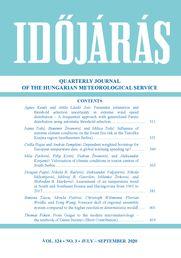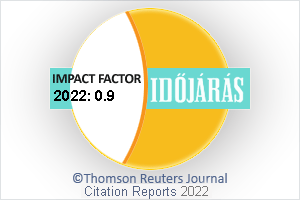IDŐJÁRÁS - angol nyelvű folyóirat
Vol. 124, No. 3 * Pages 311–426 * July - September 2020
 |
|
 letöltés [pdf: 3459 KB]
letöltés [pdf: 3459 KB]
Assessment of air temperature trend in South and Southeast Bosnia and Herzegovina from 1961 to 2017
Dragan Papić, Nikola R. Bačević, Aleksandar Valjarević, Nikola Milentijević, Milivoj B. Gavrilov, Milenko Živković, and Slobodan B. Marković
DOI:10.28974/idojaras.2020.3.5 (pp. 381–399)
Dragan Papić, Nikola R. Bačević, Aleksandar Valjarević, Nikola Milentijević, Milivoj B. Gavrilov, Milenko Živković, and Slobodan B. Marković
DOI:10.28974/idojaras.2020.3.5 (pp. 381–399)
IDŐJÁRÁS folyóirat

Az IDŐJÁRÁS a HungaroMet Nonprofit Zrt. negyedévenként megjelenő angol nyelvű folyóirata
Megrendelhető a journal.idojaras@met.hu címen.
A szerzőknek szánt útmutató itt olvasható.
Megrendelhető a journal.idojaras@met.hu címen.
A szerzőknek szánt útmutató itt olvasható.









